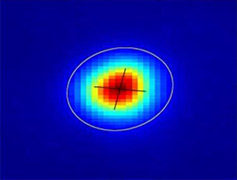
Handy Links
SLAC News Center
SLAC Today
- Subscribe
- Archives: Feb 2006-May 20, 2011
- Archives: May 23, 2011 and later
- Submit Feedback or Story Ideas
- About SLAC Today
SLAC News
Lab News
- Interactions
- Lightsources.org
- ILC NewsLine
- Int'l Science Grid This Week
- Fermilab Today
- Berkeley Lab News
- @brookhaven TODAY
- DOE Pulse
- CERN Courier
- DESY inForm
- US / LHC
SLAC Links
- Emergency
- Safety
- Policy Repository
- Site Entry Form

- Site Maps
- M & O Review
- Computing Status & Calendar
- SLAC Colloquium
- SLACspeak
- SLACspace
- SLAC Logo
- Café Menu
- Flea Market
- Web E-mail
- Marguerite Shuttle
- Discount Commuter Passes
-
Award Reporting Form
- SPIRES
- SciDoc
- Activity Groups
- Library
Stanford
Around the Bay
LCLS Team Takes Pictures of the Electron Beam
 How do you take a picture of something as thin as a strand of hair that's moving at the speed of light?
How do you take a picture of something as thin as a strand of hair that's moving at the speed of light?
Like professionals who photograph wildlife or fussy babies, the Linac Coherent Light Source (LCLS) team is not daunted. They've adapted several technologies to take pictures of the LCLS electron beam.
The pictures ensure that the beam still looks and behaves like it's supposed to after being created by the injector, accelerated, and bent by bunch compressors. For the commissioning work done last spring and summer, researchers used 14 devices installed along the injection line to help bring the electron beam up to spec for its downstream role in creating ultrafast, ultrashort x-ray pulses.
Near the beam's source, where the beam is still low in energy, researchers are using scintillating crystals to capture the crosswise dimensions of the beam. The beam shoots through the crystals, transferring kinetic energy that makes the crystals emit light, which nearby cameras detect.
After the beam gets accelerated to higher energies, physicists use a different method to picture the beam. They place a piece of aluminum foil hundreds of times thinner than kitchen foil in the beam pipe. The beam passes straight through, but the electromagnetic field that travels with the beam interacts with the foil, reflecting light to well-positioned digital cameras.
The vacuum and mechanical manufacturing groups are adding more of these optical transition radiation (OTR) cameras to one of the areas where electron bunches get compressed.
"We've had great success with this OTR diagnostic for measuring beam size," said LCLS physicist Henrik Loos.
During the next commissioning run this winter, LCLS physicists and engineers will be working to understand and fix a problem that unexpectedly cropped up in one of the OTR devices. Under certain conditions, the electrons radiate collectively, belying the assumption that each electron radiates independently and distorting the measured image.
When working well, the OTR pictures give valuable two-dimensional information on the transverse cross-section, or diameter of the beam.
—Heather Rock Woods, SLAC Today, November 21, 2007
Above image: A camera took this image of the LCLS beam's cross section.